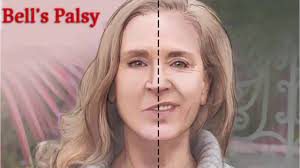Bell’s Palsy
About Bell’s palsy
Bell’s palsy is a condition in which the muscles on one side of your face become weak or paralyzed. It affects only one side of the face at a time, causing it to droop or become stiff on that side.

Cause of this disease
Most doctors believe that it’s due to damage to the facial nerve, which causes swelling. This nerve passes through a narrow, bony area within the skull. When the nerve swells even a little bit it pushes against the skull’s hard surface. This affects how well the nerve works.
Symptoms of Bell’s palsy
Signs and symptoms of Bell’s palsy come on suddenly and may include:
- Rapid onset of mild weakness to total paralysis on one side of your face — occurring within hours to days
- Facial droop and difficulty making facial expressions, such as closing your eye or smiling
- Drooling
- Pain around the jaw or in or behind your ear on the affected side
- Increased sensitivity to sound on the affected side
- Headache
- A decrease in your ability to taste
- Changes in the amount of tears and saliva you produce
In rare cases, Bell’s palsy can affect the nerves on both sides of your face.
Causes
Although the exact reason Bell’s palsy occurs isn’t clear, it’s often related to exposure to a viral infection. Viruses that have been linked to Bell’s palsy include the virus that causes:
- Cold sores and genital herpes (herpes simplex)
- Chickenpox and shingles (herpes zoster)
- Infectious mononucleosis (Epstein-Barr)
- Cytomegalovirus infections
- Respiratory illnesses (adenovirus)
- German measles (rubella)
- Mumps (mumps virus)
- Flu (influenza B)
Hand-foot-and-mouth disease (coxsackievirus)
Tests of bell palsy
There’s no specific test for Bell’s palsy. … Other conditions — such as a stroke, infections, Lyme disease and tumors — can also cause facial muscle weakness, mimicking Bell’s palsy. If the cause of your symptoms isn’t clear, your doctor may recommend other tests.
affected area of bell’s palsy
Bell’s palsy usually occurs suddenly, affecting the greater part of one side of the face. … Risk factors for Bell’s palsy include diabetes, pregnancy and Lyme disease. Bell’s palsy usually affects most of one side of the face. It can reduce the ability to blink, so the eye may become very dry.
Treatment of bell’s palsy
Medications
Commonly used medications to treat Bell’s palsy include:
- Corticosteroids, such as prednisone, are powerful anti-inflammatory agents. If they can reduce the swelling of the facial nerve, it will fit more comfortably within the bony corridor that surrounds it. Corticosteroids may work best if they’re started within several days of when your symptoms started.
- Antiviral drugs. The role of antivirals remains unsettled. Antivirals alone have shown no benefit compared with placebo. Antivirals added to steroids are possibly beneficial for some people with Bell’s palsy, but this is still unproved.However, despite this, valacyclovir (Valtrex) is sometimes given in combination with prednisone in people with severe facial palsy.
Physical therapy
Paralyzed muscles can shrink and shorten, causing permanent contractures. A physical therapist can teach you how to massage and exercise your facial muscles to help prevent this from occurring.
Surgery
In the past, decompression surgery was used to relieve the pressure on the facial nerve by opening the bony passage that the nerve passes through. Today, decompression surgery isn’t recommended. Facial nerve injury and permanent hearing loss are possible risks associated with this surgery.
Rarely, plastic surgery may be needed to correct lasting facial nerve problems.
Economical implication on its treatment
Surgery, physical therapy and medication are expensive to do because it is not a one time cost it is going to need financial help very frequently and can cost you a lot of money resulting in the need for financial aids.
Political influence in bell’s palsy treatment
government sometimes provides subsidies to the affected people or reduces prices of medicines to help affected people that’s how political influence affects people.
Social impact on bell’s palsy
People who are affected by this disease might get discriminated by their looks as there face becomes wierd when half there face is paralayzed so people also exclude them from society and discriminates them whenever they see them that’s the social impact of bell’s paulsy.